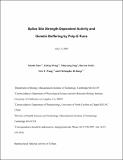Splice site strength–dependent activity and genetic buffering by poly-G runs
Author(s)
Xiao, Xinshu; Wang, Zefeng; Jang, Minyoung; Nutiu, Razvan; Wang, Eric T; Burge, Christopher B; ... Show more Show less
Downloadmain article (2.589Mb)
OPEN_ACCESS_POLICY
Open Access Policy
Creative Commons Attribution-Noncommercial-Share Alike
Terms of use
Metadata
Show full item recordAbstract
Pre-mRNA splicing is regulated through the combinatorial activity of RNA motifs, including splice sites and splicing regulatory elements. Here we show that the activity of the G-run (polyguanine sequence) class of splicing enhancer elements is approx4-fold higher when adjacent to intermediate strength 5' splice sites (ss) than when adjacent to weak 5' ss, and approx1.3-fold higher relative to strong 5' ss. We observed this dependence on 5' ss strength in both splicing reporters and in global microarray and mRNA-Seq analyses of splicing changes following RNA interference against heterogeneous nuclear ribonucleoprotein (hnRNP) H, which cross-linked to G-runs adjacent to many regulated exons. An exon's responsiveness to changes in hnRNP H levels therefore depends in a complex way on G-run abundance and 5' ss strength. This pattern of activity enables G-runs and hnRNP H to buffer the effects of 5' ss mutations, augmenting both the frequency of 5' ss polymorphism and the evolution of new splicing patterns. Certain other splicing factors may function similarly.
Date issued
2009-09Department
Whitaker College of Health Sciences and Technology; Massachusetts Institute of Technology. Department of BiologyJournal
Nature Structural and Molecular Biology
Publisher
Nature Publishing Group
Citation
Xiao, Xinshu et al. “Splice site strength–dependent activity and genetic buffering by poly-G runs.” Nature Structural & Molecular Biology 16 (2009): 1094-1100.
Version: Author's final manuscript
ISSN
1545-9993
1545-9985